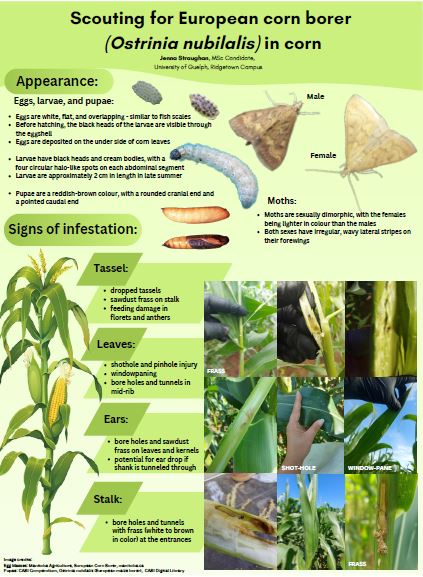In case you missed it, we announced earlier this year that ECB populations were found in Nova Scotia in the fall of 2022 that are resistant to Cry1Ab Bt protein used to control ECB in Bt corn. Given the level of injury found, the resistance was developing over a number of years and went unnoticed. These same populations were also found to be cross resistant to Cry1A.105. This follows only a few years after populations were found to be resistant to Cry1F proteins in Nova Scotia (2018), New Brunswick (2022 – not published yet), Quebec (2019) and Manitoba (2020). These detections are the first cases of field evolved resistance of ECB to Bt corn in the world. This means that ECB are resistant to three of the four proteins used in Bt corn in Nova Scotia and resistance to at least one Bt protein in three other provinces. Essentially every Bt corn hybrid contains one more more ECB Bt proteins, even if your growing Bt corn for a different pest (eg. WBC or CRW). Although it is not possible to reverse this resistance, it is possible to slow its spread by scouting and reporting any signs of injury on Bt corn early so that effective mitigation measures can be implemented.
To stay ahead of ECB resistance, we need to start routinely scouting Bt corn fields again and report any signs of unexpected injury to myself and the seed providers. Now is a great time to start looking for any signs of ECB damage. At least one generation of ECB has reached the stage where larvae would be tunneling in the tassels, mid ribs, stalks and potentially even ears of the plant. Scout 10 plants in 10 areas of the field. Look for signs of saw-dust frass at leaf axils, bent leaves with tunneling at the midrib or broken tassels where larvae entered the plants. Jenna Straughan, an MSc candidate at the University of Guelph Ridgetown Campus put together this great one pager (Scouting for European corn borer (Ostrinia nubilalis) in corn) that shows what the signs of injury and life stages of ECB look like. Take a knife and slice open the stalk of any plants with these signs and look for the tunnels and larvae that may be inside. Also check the ear shank, including where the ear connects to the plant. Any of these signs need to be reported immediately, so that plants can be checked for Bt proteins and ECB can be collected for testing.
Fields in Eastern Ontario are likely at greater risk of finding resistance first, given their proximity to the southern Quebec population found to be resistant to Cry1F near Montreal and are also close enough to the Maritimes where ECB moths may blow in from. But it is good practice for everyone in Ontario to be on watch for signs of ECB injury in Bt corn.
Our best mitigation tool to reduce the spread of ECB resistance is to shred corn stubble shortly after harvest using flail mowers to keep the ECB from successfully overwintering. ECB stay as larvae through the winter in the first 30 cm of corn stubble left on the soil surface after harvest. By shredding the corn stubble, ECB are exposed to winter temperatures and won’t survive. This keeps them from emerging as moths in the spring to fly out of these fields and further spreading resistance. Plowing intact corn stubble into the soil will not kill the ECB but rather gives them an even cozier home to ride out the winter in. Shredding corn stubble is a good practice even for non-Bt corn fields, since it helps reduce ECB populations in the local area for the following season.
